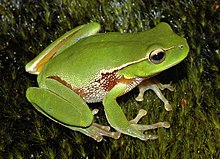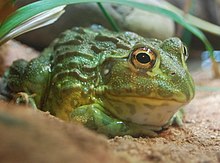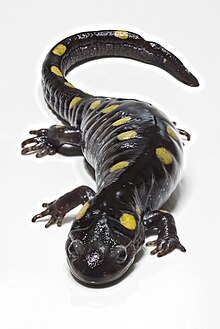Portal:Amphibians
The Amphibian Portal
Amphibians are ectothermic, anamniotic, four-limbed vertebrate animals that constitute the class Amphibia. In its broadest sense, it is a paraphyletic group encompassing all tetrapods, excluding the amniotes (tetrapods with an amniotic membrane, such as modern reptiles, birds, and mammals). All extant (living) amphibians belong to the monophyletic subclass Lissamphibia, with three living orders: Anura (frogs), Urodela (salamanders), and Gymnophiona (caecilians). Evolved to be mostly semiaquatic, amphibians have adapted to inhabit a wide variety of habitats, with most species living in freshwater, wetland or terrestrial ecosystems (such as riparian woodland, fossorial and even arboreal habitats). Their life cycle typically starts out as aquatic larvae with gills known as tadpoles, but some species have developed behavioural adaptations to bypass this.
The young generally undergo metamorphosis from larva with gills to an adult air-breathing form with lungs. Amphibians use their skin as a secondary respiratory surface and some small terrestrial salamanders and frogs lack lungs and rely entirely on their skin. They are superficially similar to reptiles like lizards, but unlike reptiles and other amniotes, require water bodies in which to breed. With their complex reproductive needs and permeable skins, amphibians are often ecological indicators; in recent decades there has been a dramatic decline in amphibian populations for many species around the globe.
The earliest amphibians evolved in the Devonian period from sarcopterygian fish with lungs and bony-limbed fins, features that were helpful in adapting to dry land. They diversified and became ecologically dominant during the Carboniferous and Permian periods, but were later displaced in terrestrial environments by early reptiles and basal synapsids (mammal predecessors). The origin of modern amphibians belonging to Lissamphibia, which first appeared during the Early Triassic, around 250 million years ago, has long been contentious. The most popular hypothesis is that they likely originated from temnospondyls, the most diverse group of prehistoric amphibians, during the Permian period. Another hypothesis is that they emerged from lepospondys. (Full article...)
Selected frog article
Selected salamander article

Sexual selection in amphibians involves sexual selection processes in amphibians, including frogs, salamanders and newts. Prolonged breeders, the majority of frog species, have breeding seasons at regular intervals where male-male competition occurs with males arriving at the waters edge first in large number and producing a wide range of vocalizations, with variations in depth of calls the speed of calls and other complex behaviours to attract mates. The fittest males will have the deepest croaks and the best territories, with females making their mate choices at least partly based on the males depth of croaking. This has led to sexual dimorphism, with females being larger than males in 90% of species, males in 10% and males fighting for groups of females.
There is a direct competition between males to win the attention of the females in salamanders and newts, with elaborate courtship displays to keep the females attention long enough to get her interested in choosing him to mate with. Some species store sperm through long breeding seasons, as the extra time may allow for interactions with rival sperm. (Full article...)List of selected salamander articles
|
|---|
Did you know? –

- ... that the giant spiny frog is the largest frog in Hong Kong?
- ... that where their ranges overlap, the Italian cave salamander sometimes hybridises with Ambrosi's cave salamander?
- ... that Pelobates cultripes, the "Western Spadefoot Toad", produce spawn up to one metre long which can consist of 7000 eggs?
- ... that the shovelnose salamander and the blackbelly salamander both live in the Appalachian Mountains, but the former feeds exclusively in water while the latter mainly forages on land?
- ... that the large prehistoric amphibian Cyclotosaurus had a skull up to 70 cm long?
Selected amphibian type
Salamanders are a group of amphibians typically characterized by their lizard-like appearance, with slender bodies, blunt snouts, short limbs projecting at right angles to the body, and the presence of a tail in both larvae and adults. All ten extant salamander families are grouped together under the order Urodela from the group Caudata. Urodela is a scientific Latin term based on the Ancient Greek οὐρά δήλη: ourà dēlē "conspicuous tail". Caudata is the Latin for "tailed ones", from cauda : "tail".
Salamander diversity is highest in eastern North America, especially in the Appalachian Mountains; most species are found in the Holarctic realm, with some species present in the Neotropical realm. Salamanders never have more than four toes on their front legs and five on their rear legs, but some species have fewer digits and others lack hind limbs. Their permeable skin usually makes them reliant on habitats in or near water or other cool, damp places. Some salamander species are fully aquatic throughout their lives, some take to the water intermittently, and others are entirely terrestrial as adults.
This group of amphibians is capable of regenerating lost limbs as well as other damaged parts of their bodies. Researchers hope to reverse engineer the regenerative processes for potential human medical applications, such as brain and spinal cord injury treatment or preventing harmful scarring during heart surgery recovery. The remarkable ability of salamanders to regenerate is not just limited to limbs but extends to vital organs such as the heart, jaw, and parts of the spinal cord, showing their uniqueness compared to different types of vertebrates. This ability is most remarkable for occurring without any type of scarring. This has made salamanders an invaluable model organism in scientific research aimed at understanding and achieving regenerative processes for medical advancements in human and animal biology. (Full article...)Selected images
Selected toad article

The neural basis of prey detection, recognition, and orientation was studied in depth by Jörg-Peter Ewert in a series of experiments that made the toad visual system a model system in neuroethology (neural basis of natural behavior). He began by observing the natural prey catching behavior of the common European toad (Bufo bufo).
Ewert's work with toads yielded several important discoveries (Ewert 1974, 2004). In general, his research revealed the specific neural circuits for recognition of complex visual stimuli. Specifically, he identified two main regions of the brain, the tectum and the thalamic-pretectal region, that were responsible for discriminating prey from non-prey and revealed the neural pathways that connected them. Furthermore, he found that the neural mechanisms are plastic and adaptable to varying environments and conditions (Carew 2000; Zupanc 2004). (Full article...)Selected caecilian article
Typhlonectidae, also known as aquatic caecilians or rubber eels, are a family of caecilians found east of the Andes in South America.
They are viviparous animals, giving birth to young that possess external gills. Of the five extant genera in the family, Atretochoana, Potamotyphlus and Typhlonectes are entirely aquatic, while Chthonerpeton and Nectocaecilia are semi-aquatic. Atretochoana reaches 100 cm (39 in) in length, but other species in the family range from 20 to 60 cm (7.9–23.6 in). A sixth typhlonectid genus, Ymboirana, was recently described and is known exclusively from fossil material. (Full article...)Need help?
Do you have a question about Amphibians that you can't find the answer to?
Consider asking it at the Wikipedia reference desk.
Topics
Subcategories
Related portals
Associated Wikimedia
The following Wikimedia Foundation sister projects provide more on this subject:
-
Commons
Free media repository -
Wikibooks
Free textbooks and manuals -
Wikidata
Free knowledge base -
Wikinews
Free-content news -
Wikiquote
Collection of quotations -
Wikisource
Free-content library -
Wikiversity
Free learning tools -
Wiktionary
Dictionary and thesaurus










































